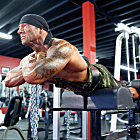 I often hear patients and trainees proudly describe how they have designed a training program that avoids any training of their lower-back muscles so they can avoid lower-back pain. They believe that’s a great accomplishment—but is it?
I often hear patients and trainees proudly describe how they have designed a training program that avoids any training of their lower-back muscles so they can avoid lower-back pain. They believe that’s a great accomplishment—but is it?
Most avoid lower-back training due to a long history of episodes of lower-back pain, which can be severe and debilitating and costs this country many billions of dollars per year in lost work production and health care. It’s obviously a very serious issue. I respect the desire and ability to find a way to stay in the gym and train with less, or no, pain; however, some of these trainees have set themselves up for more potential problems.
When you avoid lower-back exercises entirely, your spinal extensor muscles weaken and don’t provide dynamic stabilization of the spine. That weakness can set up the back for future injuries—sprains, strains or disk injuries—when the back undergoes a load. The load could be relatively simple, such as lifting a light object or even leaning forward to shave or brush your teeth. The continued episodes of even greater back pain cause more fear of back training. The end result: The back becomes weaker yet, and the cycle keeps repeating.
I have had patients come to me due to long-standing back pain. One of the first comments I hear is, “I can’t do any rehab. It always flares me up.” When I ask how long the flare-up lasts, the answer is usually, “Three days. It’s always three days, and then I improve.” I inform those patients that the pain they are feeling is most likely delayed-onset muscle soreness, which typically lasts 24 to 48 hours and starts to improve by 72 hours. Their back muscles are so deconditioned that any exercise causes soreness.
Once the history and examination are completed and it has been determined that there are no other significant causes of lower-back pain, I recommend a more gentle or subtle initial stage of rehab. It’s often very difficult for lower-back-pain patients to tell the difference between muscle soreness from rehab or training and their actual back pain. They know they have lower-back pain either way and the exercise seemed to cause it.
Another problem with avoiding back training is that an imbalance between the lower-back muscles and abdominal muscles occurs. Many trainees still think the key to lower-back pain is to have strong abdominals. While there certainly is truth in that idea, the abs do not work alone to support the lower back. The back muscles are just as important to supporting the spine.
When the abdominal muscles are very strong and the back muscles are weak, trainees typically have lower-back pain. The strong abs can flatten the curve of the lower back, which causes the spine to take too much impact without the normal curve bending and allowing the force to be absorbed. That’s loosely called flat-back syndrome.
Those trainees who are able to still train—or try to train—their backs should do so carefully and progressively. You may need to start exercises that engage your lower back without weight and also with only a couple of total sets. It is not wise to start with 12 to 20 sets made up of four exercises for three to five sets each. Your back muscles are no longer capable of handling such a load. Also, it is worthless to remember the weight you used to handle years ago. Always ask yourself, “When is the last time I handled this type of weight?” If the answer is not, “Recently,” then you must reduce the weight significantly and allow your body the chance to build strength again without straining.
I’m not suggesting that you return to heavy deadlifts, but a little work for your lower back will keep many of you feeling better and with less risk of lower-back-pain episodes. Those who still have pain even with a gentle approach to strengthening your back should be guided by a health-care practitioner who, I hope, has a background in strength coaching or training.
Until next month, train smart.
Editor’s note: Visit www.SoftTissueCenter.com for reprints of Horrigan’s past Sportsmedicine columns that have appeared in IRON MAN. You can order the books, Strength, Conditioning and Injury Prevention for Hockey by Joseph Horrigan, D.C., and E.J. “Doc” Kreis, D.A., and the 7-Minute Rotator Cuff Solution by Horrigan and Jerry Robinson from Home Gym Warehouse, (800) 447-0008 or at www.Home-Gym.com.




















You must be logged in to post a comment Login